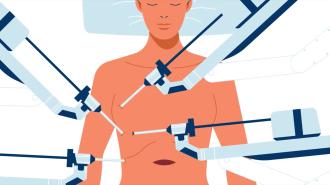Surgeons in Spain have performed what they say is the first fully robotic lung transplant — and their unique approach to the procedure appears to make it less risky and painful for patients.
The challenge: A lung transplant can be life-saving, but it’s also a hugely invasive procedure — traditionally, surgeons cut a nearly foot-long incision across a patient’s chest and split open their breastbone to access their lungs.
This approach often leads to a long, painful recovery, typically involving opioid painkillers that can be addictive. Transplant recipients are also at high risk of infection due to the immune-suppressing drugs they must take to prevent organ rejection. An infection in the large wound can prevent it from closing properly — sometimes necessitating another surgery and further delaying recovery.
“We believe it is a technique that will improve patients’ life quality, the post-surgery period, and reduce pain.”
Albert Jauregui
A 3-inch incision: Researchers at Vall d’Hebron University Hospital in Spain have demonstrated a new lung transplant procedure that allowed them to remove and replace a patient’s damaged lung through a 3-inch incision.
Not only was the transplant successful, the patient recovered faster than normal, without opioids.
“We believe it is a technique that will improve patients’ life quality, the post-surgery period, and reduce pain,” said Albert Jauregui, head of the Thoracic Surgery and Lung Transplants Department at Vall d’Hebron. “We hope this technique will eventually spread to more centers.”
How it works: During the lung transplant, surgeons made their 3-inch cut just above the diaphragm of their patient, a 65-year-old man named Xavier. They then used a soft tissue retractor to spread open the incision.
“It’s a part of the body that has the advantage of having a very elastic skin, which gives room to widen the opening without having to touch a single rib,” Jauregui said.
“I had zero pain.”
Xavier
The four arms of a surgical robot named Da Vinci were inserted into the patient’s chest through a few other tiny cuts, each less than .5-inch long.
One of the arms held a camera that allowed the surgeons to see inside the patient. The other three arms were topped with surgical instruments to separate the diseased lung from the heart and guide it out the opening above the diaphragm.
Once that part of the procedure was finished, a deflated donor lung was inserted through the opening, and surgeons then used Da Vinci’s arms to attach it to the patient’s body. The small incisions were then closed.
“From the moment I regained consciousness and woke up from general anesthesia, I had zero pain,” said Xavier.
The big picture: Vall d’Hebron isn’t the only hospital using robots to make lung transplants less invasive. In 2022, a team at Cedars-Sinai Hospital in Los Angeles performed a robot-assisted lung transplant after making a 3-inch incision between their patient’s ribs.
Part of that surgery was still performed manually, though, according to the Vall d’Hebron team, which claims their operation is the first example of a fully robotic lung transplant. It’s also the first time the procedure has been performed through the opening below the diaphragm.
“This novel surgical technique allows us to cut a small section of skin, fat, and muscle, leaving a wound that closes easily,” said Jauregui. “Not only is this much safer than the traditional method, but for this first patient it has been virtually painless.”
“This is a historic milestone which we believe will improve the lives of thousands of patients,” he added.
We’d love to hear from you! If you have a comment about this article or if you have a tip for a future Freethink story, please email us at [email protected].





